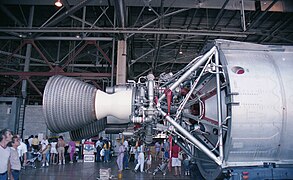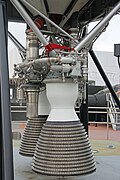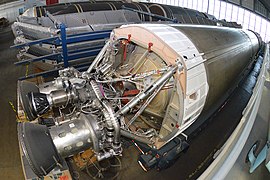This article needs additional citations for
verification. (June 2014) |
 XLR87 Rocket Engine | |
| Country of origin | United States |
|---|---|
| First flight | 1959 |
| Last flight | 2005 |
| Manufacturer | Aerojet |
| Application | Titan Main engine |
| Successor | D LR-91 |
| Liquid-fuel engine | |
| Propellant |
|
| Cycle | Gas-generator |
| Performance | |
| Thrust, sea-level | LR87-11: 1,900 kN [1] |
| Chamber pressure | 40–59 bar |
| Specific impulse, vacuum | 2,840 N‑s/kg (290 s) |
| Specific impulse, sea-level | 2,510 N‑s/kg (256 s) |
| Dimensions | |
| Length |
|
| Diameter | 1.14 m |
| Dry weight | 839 kg |
The LR87 was an American liquid-propellant rocket engine used on the first stages of Titan intercontinental ballistic missiles and launch vehicles. [1] Composed of twin motors with separate combustion chambers and turbopump machinery, [2] it is considered a single unit and was never flown as a single combustion chamber engine or designed for this. The LR87 first flew in 1959. [1]
The LR87 was developed in the late 1950s by Aerojet. [3]: 82,319 It was the first production rocket engine capable (in its various models) of burning the three most common liquid rocket propellant combinations: liquid oxygen/ RP-1, nitrogen tetroxide (NTO)/ Aerozine 50 (a 50:50 mixture by mass of hydrazine and UDMH), and liquid oxygen/ liquid hydrogen. [4] The engine operated on an open gas-generator cycle and utilized a regeneratively cooled combustion chamber. For each thrust chamber assembly, a single high-speed turbine drove the lower-speed centrifugal fuel and oxidizer pumps through gearing, a configuration designed for high turbopump efficiency. This lowered fuel use in the gas generator and improved specific impulse. [3]: 380-385 The LR87 served as a template for the LR-91, which was used in the second stage of the Titan missile. [5]
The LR87 was a fixed-thrust engine, which could not be throttled or restarted in flight. The LR87 delivered approximately 1,900 kilonewtons (430,000 pounds) of thrust in its hypergolic configuration. [1] Early LR87 engines used on the Titan I burned RP-1 and liquid oxygen. [6] [1] Because liquid oxygen is cryogenic, it could not be stored in the missile for long periods of time, and had to be loaded before the missile could be launched. For the Titan II, the engine was converted to use Aerozine 50 and nitrogen tetroxide, which are hypergolic and storable at room temperature. This allowed Titan II missiles to be kept fully fueled and ready to launch on short notice. [1]
For the Titan III and IV, which were larger, more capable space launch vehicles, the LR87 was modified further. Thrust and nozzle area ratio were progressively increased, requiring heavier turbopumps, pipes, and other parts. [3]: 384
Variants
LR87-3
Used on the Titan I, the LR87-3 burned liquid oxygen and RP-1. [4] Following the retirement of the Titan missile program, these engines saw no further use.[ citation needed] The LR87-3 was also operated with NTO/Aerozine 50 and ground tested with LOX/H2 (with a new fuel pump), making it one of very few engines to have been run on three different propellant combinations. [3]: 383
-
Titan I LR87-3 ( Steven F. Udvar-Hazy Center)
-
Titan I LR87-3 ( Cordele, GA)
-
Titan I LR87-3 ( Evergreen Aviation & Space Museum)
LR87-5
Instead of liquid oxygen and RP-1, the Titan II used nitrogen tetroxide and Aerozine 50. This change was done for storability at the request of the US Air Force. [3]: 381 The engine was generally lighter and simpler than its predecessor, partly due to the use of hypergolic propellants, which do not need an independent ignition system. The engines also had simpler controls, solid-propellant cartridges to start the turbopumps, simplified injectors, and autogenous pressurization, replacing the heavy tanks of cold helium gas. Instead, the fuel tank was pressurized with fuel-rich gas-generator exhaust, and the oxidizer tank with NTO evaporated in a heat exchanger using turbine exhaust. [3]: 383
Beginning in 1984, Titan II missiles were decommissioned and became available as launch vehicles. Their engines were modified for this use. [3]: 383
-
Titan II LR87-5 ( Titan Missile Museum)
-
Titan II LR87-5 ( Kansas Cosmosphere and Space Center)
-
Titan II LR87-5 ( LRAFB)
LR87-7
The LR87-5 was adapted to the needs of the Gemini program. The LR87-7 had added redundancies and safety features for human-rating certification. [3]: 381 The performance was similar to the previous version, only reducing the chamber pressure and nozzle thrust to meet human-rating requirements. This version was only used on the Titan II GLV.
-
Titan II GLV LR87-7 ( Kennedy Space Center)
-
Titan II GLV LR87-7 ( Kennedy Space Center)
LR87-9
|
| This section needs expansion. You can help by
adding to it. (April 2014) |
Used on the Titan IIIA, IIIB, and IIIC. [7]
LR87-11/LR-87-11A
|
| This section needs expansion. You can help by
adding to it. (April 2014) |
Used on Titan 24B, 34B, IIIBS, IIID, 34D, 34D7, IIIE. The LR-87-11A was used on the Titan IV A/B.[ citation needed]
-
LR-87-11A ( Wings Over the Rockies Air and Space Museum)
-
LR-87-11A ( Evergreen Aviation & Space Museum)
-
LR-87-11A ( National Museum of the United States Air Force)
LR87 LH2
|
| This section needs expansion. You can help by
adding to it. (April 2014) |
Modified to burn liquid oxygen and liquid hydrogen. The development coincided with other variants of the late 1950s. Compared to the -3, it had a number of changes associated with the use of lighter and colder liquid hydrogen. [3]: 383 The fuel injectors were greatly modified, and the RP-1 pump was replaced with a purpose-designed single-stage hydrogen pump. Developed 1958–1961, a total of 52 static tests were performed without serious issue. Aerojet took part in the selection process for a new engine for the second stage of the Saturn IB and Saturn V. Though LR87 LH2 was the best in 10 out of 11 criteria, NASA selected Rocketdyne's J-2. Lessons learned were used during development of the Aerojet M-1. [8] It was only built with 1 chamber.[ citation needed]
LR87 / Alumazine
|
| This section needs expansion. You can help by
adding to it. (October 2022) |
The LR87 was also tested with a gelled Dinitrogen Tetroxide / Alumizine fuel. [9] [10] Though the earlier tests with the LR87 were terminated due to combustion instabilities and funding restraints development of gelled fuel and oxidizers continued to produce fuels for engines currently used in space. [11]
Engine comparison
| Engine | LR87-3 | LR87-5 | LR87-7 | LR87-9 | LR87-11 | LR87 LH2 |
|---|---|---|---|---|---|---|
| Aerojet Model | AJ23-130 | AJ23-132 | AJ23-134 | AJ23-136 | AJ23-139 | |
| Fuel | LOX/Kerosene | N2O4/Aerozine 50 | N2O4/Aerozine 50 | N2O4/Aerozine 50 | N2O4/Aerozine 50 | LOX/LH2 |
| First flight | 1959 | 1962 [a] | 1962 | 1966 | 1968 | – |
| Number built | 140 | 212 | 534 | |||
| Thrust, [b] V [c] | 733.9 kN | 1096.8 kN | 1086.1 kN | 1218.8 kN | 667 kN | |
| ISP, V [c] | 290s | 297s | 296s | 302s | ||
| Thrust, SL [d] | 647.9 kN | 956.5 kN | 946.7 kN | 956.1 kN | 968.4 kN | 578 kN |
| ISP, SL [d] | 256s | 259s | 258s | 250s | 350 s | |
| Burn time | 138s | 155s | 139s | 200s | ||
| Height | 3.13m | 3.13m | 3.13m | 3.13m [e] | 4 m | |
| Diameter | 1.53m | 1.14m | 1.53m | 1.14m | 1.14 m | |
| Mass [b] | 839 kg | 739 kg | 713 kg | 758 kg | 700 kg | |
| Chamber pressure | 40.00 bar | 53.3 atm (54.01 bar) | 47.00 bar | 58.3 atm (59.07 bar) | ||
| Area ratio | 8 | 8 | 9 | 15 | 8 | |
| TWR, V [c] | 89.2 | 151.34 | 155.33 | 163.96 | 97.14 | |
| Oxidizer/fuel ratio | 1.91 | 1.93 | 1.9 | 1.91 | ||
| Coefficient of Thrust, V [c] | 1.8453 | 2.23 | 3.03 | |||
| Coefficient of thrust, SL [d] | 1.6453 | 1.98 | 2.78 | |||
| Propellant flow | 750 kg/s | 824.7 kg/s | ||||
| Source | [12] | [2] | [13] | [14] | [15] | [8] |
See also
References
- ^ a b c d e f "Aerojet-General LR87 Liquid Rocket". National Museum of the US Air Force. Archived from the original on 2010-12-25. Retrieved 2010-12-25.
- ^ a b "LR87-5". Astronautix. Archived from the original on August 5, 2014. Retrieved January 6, 2015.
- ^ a b c d e f g h i Sutton, George P. (2006). History of liquid propellant rocket engines. Reston, Va.: American Institute of Aeronautics and Astronautics. ISBN 1-56347-649-5. OCLC 63680957. Retrieved 2021-08-22.
- ^ a b "LR87". www.astronautix.com. Archived from the original on 2021-08-22. Retrieved 2021-08-22.
- ^ "LR91". www.astronautix.com. Archived from the original on 2021-08-22. Retrieved 2021-08-22.
- ^ "Titan I". www.astronautix.com. Archived from the original on 2021-04-23. Retrieved 2021-08-21.
- ^ Brügge, Norbert. "Titan III/IV Propulsion". B14643.de. Norbert Brügge. Archived from the original on 12 September 2017. Retrieved 20 June 2017.
- ^ a b "LR87 LH2". www.astronautix.com. Archived from the original on 2021-08-27. Retrieved 2021-08-27.
- ^ "LR87 Alumazine". Retrieved 2022-10-29.
- ^ "Gelled dinitrogen tetroxide composition". Retrieved 2022-10-29.
- ^ "A Comprehensive Study on Gelled Propellants". Retrieved 2022-10-29.
- ^ "LR87-3". www.astronautix.com. Archived from the original on 2021-08-27. Retrieved 2021-08-27.
- ^ "LR87-7". Astronautix. Archived from the original on March 8, 2016. Retrieved April 20, 2016.
- ^ "LR87-9". www.astronautix.com. Archived from the original on 2021-08-27. Retrieved 2021-08-27.
- ^ "LR87-11". www.astronautix.com. Archived from the original on 2021-08-27. Retrieved 2021-08-27.












